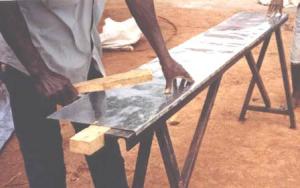Credits: Biovision-Infonet
Many rainwater harvesting installations do not perform as well as expected because of unsatisfactory gutters. It is therefore important to give careful attention to the materials used, the way the gutters are fabricated and the way they are installed. Ways of fabricating and installing low-cost gutters are described below.
Semi-circular gutters
The best known gutter is semi-circular and made either of galvanized iron sheet or PVC. Gutters are laid in gutter brackets nailed onto facia-boards or in V-shaped tree branches nailed to the rafters with a gradient sloping towards the water tank. Bamboo and Sisal poles can also be used as gutters when split in two halves.

(c) E. Nissen-Petersen, Kenya

(c) E. Nissen-Petersen, Kenya
Splash-guards

(c) E. Nissen-Petersen, Kenya
They prevent rainwater from over-shooting gutters. They are made of strips of iron sheets bent at an angle and nailed onto the roof. Gutters are suspended with from the splash-guard using galvanized wires.
How to make and install Gutters with Splash-Guard

(c) E. Nissen-Petersen, Kenya
Cut galvanized plain iron sheets of gauge 26 or 28 into three strips, each being 200 cm long and 33.3 cm wide by marking the sheets with a thick wire, about 40 cm long, with each end having a sharp bend and a pointed end to scratch a line.
The distance between the two bends must be 33.3 cm in order to make equal width of the cut sheets.
- The metal strips are bent over a U-shaped piece of iron and hammered into shape with a piece of wood or a mallet.

(c) E. Nissen-Petersen, Kenya
The shape of the metal strips depends on whether they shall be splash-guards or gutters with one of the shapes shown below: namely the V-shaped gutter, the square gutter and the semi-circular gutter.

(c) E. Nissen-Petersen, Kenya

(c) E. Nissen-Petersen, Kenya

(c) E. Nissen-Petersen, Kenya

(c) E. Nissen-Petersen, Kenya
Gutters are fitted into hangers made of 3 mm galvanised wires that are bent over nails hammered into a piece of wood.

(c) E. Nissen-Petersen, Kenya
How to install Gutters
Gutters should be installed with a gradient of 10 cm depth for every 10 m length of a roof. This gradient of 1:100 will facilitate rain water running off the gutter with high velocity and no water will be wasted due to overflow.
The high velocity of the water will transport leaves and debris to the inlet sieve without blocking the gutter.

(c) E. Nissen-Petersen, Kenya

(c) E. Nissen-Petersen, Kenya

(c) E. Nissen-Petersen, Kenya
A gutter hanger is tied to the splash-guard with its bottom at the level of the water in the hosepipe. A second hanger is tied to the other end of the splash-guard near the tank.
This hanger is tied to the splash-guard with a slope 1:100 below the water level in the hosepipe. A gradient of 1:100 is distance is found by dividing the length of a roof with a factor of 100.
For example; if a roof is 20 m long, the hanger at the water tank must be 20 cm lower than the other hanger to get the desired gradient of 1:100.

(c) E. Nissen-Petersen, Kenya

(c) E. Nissen-Petersen, Kenya
Two hangers are attached to the first gutter with one hanger at the middle and the other hanger at the end of the gutter.
Bitumen is smeared on the inner end of first gutter before a second gutter is laid into it and so on until the whole length of gutter is installed.
Other Types of Gutters

(c) E. Nissen-Petersen, Kenya

(c) E. Nissen-Petersen, Kenya